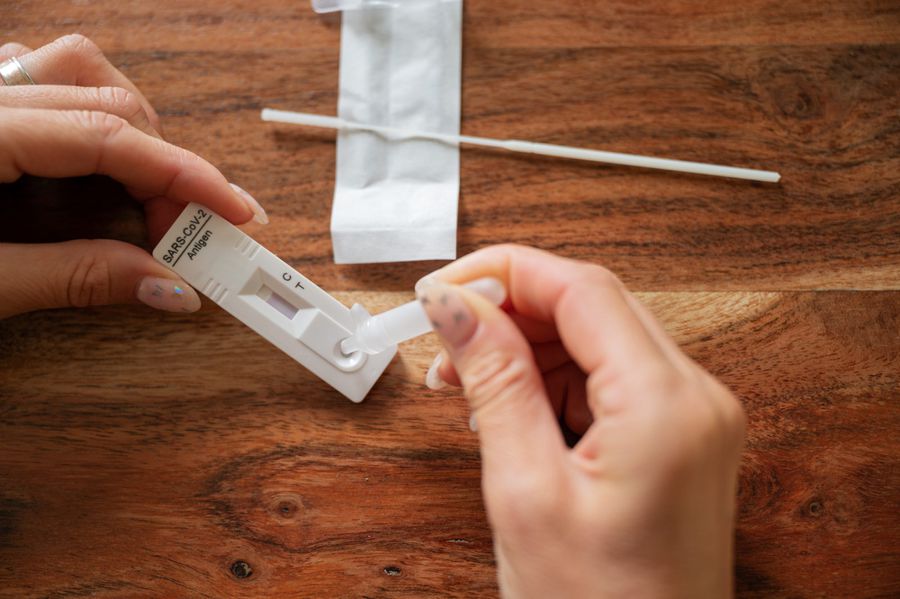
At-home COVID tests are arguably one of the most convenient inventions in recent years. Thanks to these now widely available kits, we no longer have to visit the doctor or wait in long lines to get tested for the coronavirus. Instead, people of all ages—including kids—can quickly and easily receive a diagnosis from the comfort of their homes.
That said, recent news reports have indicated some at-home COVID tests contain a potentially hazardous substance called sodium azide. This chemical, which is used as a preservative, can cause serious illness when swallowed, and it can also irritate the skin and eyes.
Naturally, parents across the country have expressed their concerns, but experts say not to worry. At-home COVID tests contain a very small amount of sodium azide that's unlikely to cause harm. Plus, if you follow directions for at-home COVID tests properly, they don't pose any health hazard. Here's everything you need to know, with expert tips on how to safely use rapid at-home COVID tests.
What is Sodium Azide?
To understand the concerns, parents must first learn about the chemical found in at-home COVID tests. “Sodium azide is commonly used as a preservative,” explains Kelly Johnson-Arbor, M.D. a medical toxicologist and co-medical director of the National Capital Poison Center. “It is also a component of some automobile airbag systems and airplane evacuation slides (it acts as a propellant and causes inflation of these devices).” The Centers for Disease Control and Prevention (CDC) adds that it’s used as a pest control agent too.
Sodium azide is colorless, odorless, and tasteless. When swallowed, even small amounts can cause dangerously low blood pressure in humans. In higher doses, consumption of sodium azide can cause heart rhythm problems, build-up of acids in the body, lung injury, respiratory issues, and even death. If it comes in contact with the skin or the eyes, sodium azide can cause irritation, redness, or pain.
Why is Sodium Azide in At-Home COVID Tests?
If you're wondering why a substance like this would be included in at-home COVID tests, you're not alone. Sodium azide is actually found in the reagent liquid, which is mixed with the sample of bodily fluid (often in the form of a nasal swab) to produce the positive or negative result.
“The reagent fluid in COVID-19 home test kits contains various chemicals including inorganic phosphate, ProClin 300 (a surfactant), and sodium azide,” Dr. Johnson-Arbor says. “Several brands of home COVID-19 tests—including BinaxNow, BD Veritor, Celltrion DiaTrust, and FlowFlex—utilize this reagent fluid, which does contain sodium azide in varying amounts.”
Reportedly, the amount of sodium azide used in COVID tests is “small,” according to a source in a USA Today article, and it’s not likely to cause serious harm. If you use the test properly, you shouldn’t come in contact with the chemical at all.
Are At-Home COVID Tests Safe to Use?
When used properly, at-home COVID tests are generally safe for people of all ages. According to USA Today, the documented sodium azide poisonings have been minor, thanks to the small amount used in the tests. They’ve stemmed from incidents like the chemical splashing on skin during testing, and vials containing the reagent being mistaken for contact lens solution or eye drops.
Despite these facts, we've included some tips for parents to ensure a safe COVID testing experience for the whole family.
Tips for Safely Use an At-Home COVID Test
Following basic safety precautions while taking or administering an at-home COVID-19 test can ensure everyone stays safe. It also helps you get accurate results. Below, Dr. Johnson-Arbor gives some tips for safely using an at-home COVID test.
- Before using a home COVID-19 test kit, read the instructions and follow them carefully.
- Consider using gloves when handling these kits.
- Use the test only as directed.
- Do not swallow the reagent fluid, and avoid getting it in your eyes or on your skin.
- Keep the test kits and their contents out of the reach of children.
- Do not keep the test kits near prescription or over-the-counter medications. Some of the reagent fluid tubes resemble eye drop bottles and can be easily mistaken for them.
- After using a test, dispose of it immediately in the trash—preferably somewhere inaccessible to children. Do not leave the test kit components on counters, tables, nightstands, or other high-touch surfaces.
